December 2022 LIP of the Month
The Snowbird Tectonic Zone Large Igneous Province (STZ LIP): a failed rift origin
Regan, S.P.1, M.L. Williams2, J.R. Chiarenzelli3, B. Cousens4, L. Aspler5, L. Zieman6, J.R. Webber7, M.J. Jercinovic2
- Geophysical Institute, University of Alaska, Fairbanks, Fairbanks AK 99775; sregan5@alaska.edu
- University of Massachusetts, Amherst, Amherst, MA
- Lawrence University, Canton, NY
- Ottawa-Carleton Geoscience Centre, Dept. of Earth Sciences. Carleton University, Ottawa, Ontario, Canada, K1S 5B6
- British Columbia Geological Survey, Victoria, British Columbia, Canada V8W 9N3
- Department of Geosciences, University of Arizona, Tucson, AZ 85721, USA
- Stockton University, Galloway, NJ 08205
Extracted from and for full details see: Regan, S.P., Williams, M.L., Zieman, L., Chiarenzelli, J.R., Jercinovic, M.J., Cousens, B.L., Webber, J.R., and Aspler, L.B., 2022, IN-SIMS zircon U-Pb geochronology from the Snowbird tectonic zone Large igneous Province (STZ LIP), western Churchill Province, Canada: Precambrian Research, v. 377, 14 p.
Introduction
The Snowbird Tectonic Zone (STZ) is a 2800 km long geophysical lineament bisecting the western Churchill Province, Canada (Fig. 1; Hofmann, 1988). Historically interpreted as the boundary between Rae and Hearne subprovinces, the geologic significance of the STZ has had varied, with interpretations including: 1) a Paleoproterozoic suture between Rae and Hearne subprovinces (Berman et al., 2007; Card et al., 2021); an intracontinental shear zone of Archean (Hanmer et al., 1994) or Paleoproterozoic (Regan et al., 2017a) age; and 3) a 1.9 Ga intracontinental rift (Flowers et al., 2006). Current debate centers on the interpretation of widespread high-grade Paleoproterozoic metamorphism that occurs along much of the STZ. Some workers invoke an allochthonous origin, with the Hearne subprovince having collided with the Rae subprovince at ca. 1.91 Ga after the consumption of ocean basin beneath the Rae (Card et al., 2021), whereas others interpret complex Paleoproterozoic deformation along the STZ as a result of intracontinental deformation driven by accretionary and collisional tectonics on the margin of the western Churchill Province (Regan et al., 2014, 2017b).
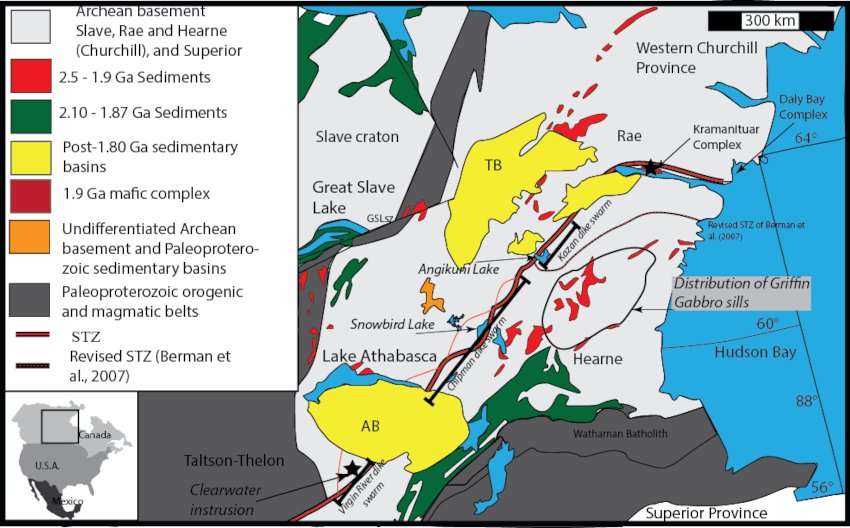
Figure 1: Simplified regional map of the western Canadian Shield
Paleoproterozoic mafic intrusive rocks are a major component of the STZ along much of its length, and may be the only common link along the entirety of the geophysical lineament (Williams and Flowers, 2008). From south to north, the STZ LIP has traditionally been interpreted to be composed of the 1) Virgin River dikes and Clearwater anorthosite complex, 2) Chipman dike swarm, 3) Kazan dike swarm, 4) Kraminituar Complex, and 5) the Daly Bay complex (Fig. 1). Daly Bay and Kramintuar complexes along the northern STZ are well-dated at ca. 1.9 Ga (Hanmer et al., 2001; Sanborn-Barrie et al., 2001). However, the complex deformational history and granulite-facies overprint of the Chipman and Virgin River dikes has made establishing igneous crystallization ages difficult, and interpretations of a ca. 1.9 Ga origin is based on ID-TIMS zircon geochronology from leucosomal pockets within melted Chipman dikes (Flowers et al., 2006). Card et al. (2014) analyzed the Clearwater anorthosite complex south of Athabasca Basin and obtained a ca. 2.1 Ga crystallization, calling into question the ca. 1.9 Ga origin for at least the Virgin River dikes by extension. Therefore, a ca. 1.9 Ga origin for all dike swarms along the central segment of the STZ is tenuous, and geochronology from mafic dike swarms is needed to establish their correlation and tectonic significance, as well as develop a broader understanding of the LIP record from the western Churchill Province.
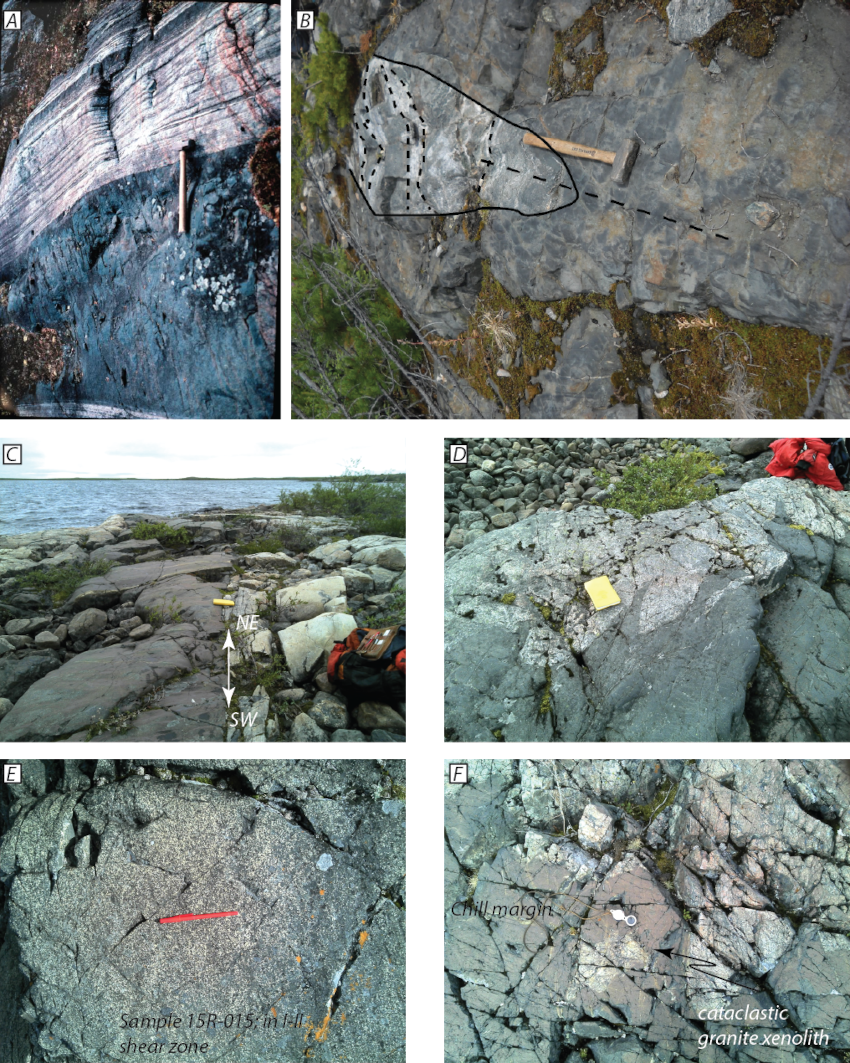
Figure 2: Field photographs of the Chipman and Kazan dike swarms. A-B) Chipman dike swarm; C-F) Photos of the Kazan dike swarm. Note the lack of deformational fabrics in the Kazan dikes as well as their sharp and high angle cross cutting contacts with host rocks.
The Chipman dike swarm (Fig. 2a,b) was the focus of a previous LIP of the Month (January 2008), and here we focus purely on new data and implications. For more background please visit Williams and Flowers (2008 – Jan 2008 LIP of the month) and Flowers et al. (2006). However, our new observations on the Kazan dikes are explored here as this dike swarm has seen minimal work.
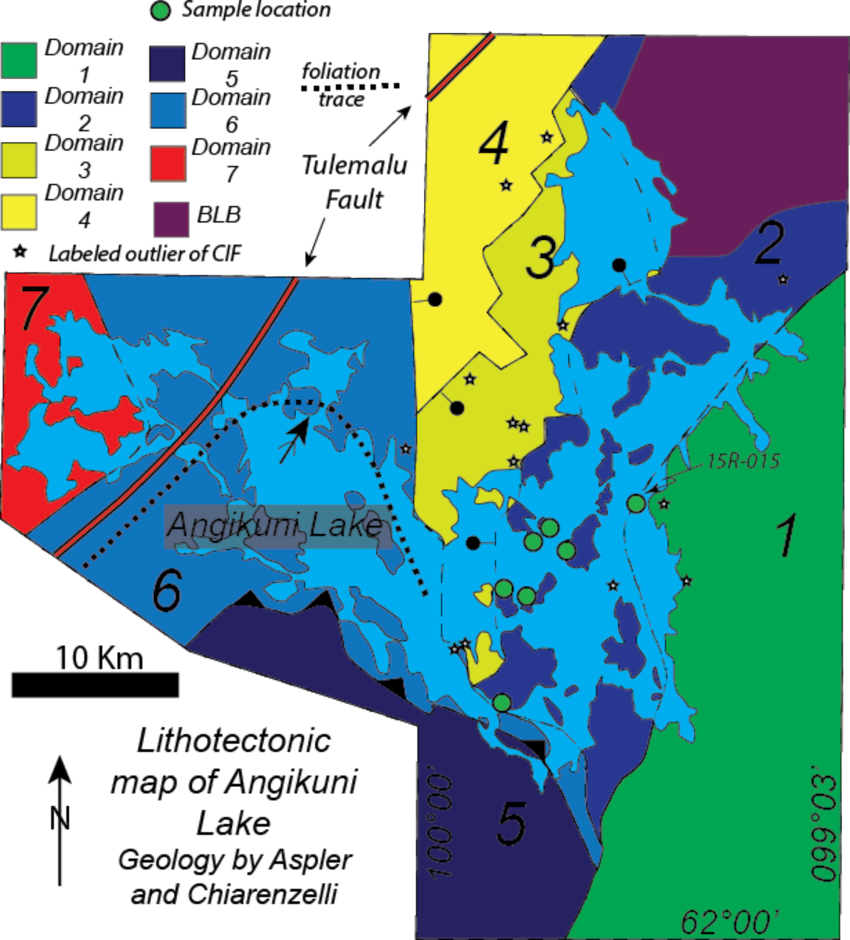
Figure 3: Generalized map of Angikuni Lake, Nunanvut (Asper et al., 1999). The Kazan dike swarm is restricted to domain II.
Kazan dike swarm
The Kazan dike swarm is a relatively understudied mafic dike swarm exposed at Angikuni Lake (Fig. 3), Nunavut located along the northern portion of the central STZ (Fig. 1,2c-f). The bedrock geology at Angikuni Lake, described in detail in Aspler et al. (1998, 1999), is summarized as a paneling of amphibolite-facies gneiss domains juxtaposed against greenstone belts. The Kazan dikes are restricted to a northeast trending and fault bound zone of Neoarchean amphibolite-facies pelitic to psammitic gneiss and variably deformed leucogranite (Domain 2 above). The dikes have a northeast trend, and locally form plutonic bodies several kilometers wide in map view. Unlike the Chipman and Virgin River dike swarms farther to the south, the Kazan dikes preserve minimal evidence of regional metamorphism aside from locally developed and microscopic garnet coronae. The preservation of delicate igneous features including subophitic texture and spinel-clouded plagioclase are consistent with minimal deformation. In the field, the Kazan dikes are medium- to coarse- grained, equigranular, hornblende-plagioclase dikes with evidence for local cleavage formation near domain bounding fault zones as described by Eade (1986). Numerous examples of Kazan dikes cross cutting regional gneissosity are preserved on well-exposed shoreline outcrops throughout eastern Angikuni Lake. In the northeastern portion of Angikuni Lake, the dikes form spectacular box-like networks cross-cutting gneisses. The Kazan dikes cross-cut epidote-bearing, leucogranitic fault breccias firmly establishing their emplacement late in the structural evolution of the region.
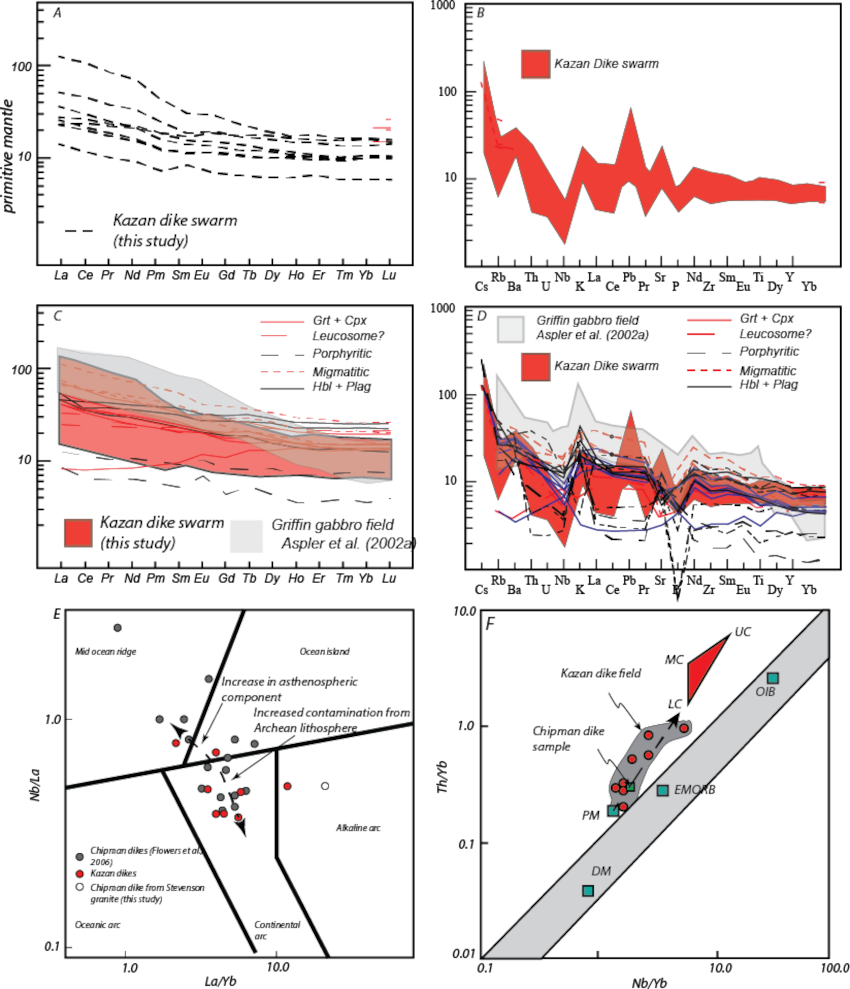
Figure 4: Geochemical comparisons between Chipman and Kazan dike swarms as well as the Griffin gabbro sills (Aspler et al., 2002).
Samples were collected along a transect perpendicular to the predominant strike of the dikes and across the entire exposed extent. Eight samples were selected for detailed petrography, major and trace element geochemical analysis, and whole rock Sm-Nd isotopic analysis. Geochemical data from the Kazan dikes are nearly identical to the Chipman dike swarm (Fig. 4; Flowers et al., 2006). They plot as sub-alkaline basalts with enriched-MORB characteristics. Incompatible element diagrams show slight depletions in HFSE and enrichments in LILE, typically indicative of a subduction-related source (Fig. 4). Sm-Nd isotopic data range from -4.67 to +2.18 εNd(Tc) (Tc = 2.1 Ga; see below) and have Neo to Mesoarchean TDM consistent with an upper asthenospheric-sourced magma that underwent significant amounts of contamination from a Neoarchean subduction-altered lithospheric mantle known to underlay the region (Cousens et al., 2001).
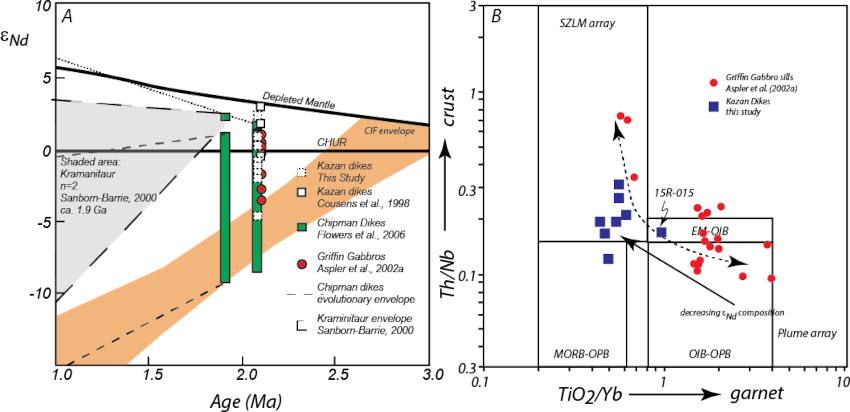
Figure 5: A) Nd isotopic data from the Kazan and Chipman (Flowers et al., 2006) dike swarms compared to the Kramintuar (Sanborn-Barrie, 2000) and Christopher Island Formation envelope (Cousens et al., 2001). B) LIP printing diagram (Pearce et al., 2021)
IN-SIMS of Chipman and Kazan dike swarms
Direct constraints on crystallization ages for the Chipman and Kazan dikes has been limited to possible correlations to the well-characterized 1.9 Ga Kramintuar and Daly Bay complexes exposed along the northernmost STZ (Sanborn-Barrie et al., 2001; Hanmer and Williams, 2001). However, no igneous crystallization ages existed from the major dike swarms that compose the STZ LIP prior to this work. We searched for zircon with primary morphologies using EPMA WDS full thin section mapping to identify igneous zircon from both Chipman and Kazan dike swarms (Fig. 6). We then drilled and mounted thin section fragments containing the identified zircon and analyzed the grains via IN-SIMS at UCLA following procedures outlined in Chamberlain et al. (2010) and Regan et al. (2022). For full analytical methods, see (Regan et al., 2022) and Figure 7.
Primary zircon is exceedingly rare in both Chipman and Kazan dike swarms. However, two samples of the Chipman dikes and one sample of the Kazan dikes contained several zircon grains with igneous morphology. Several analyses of each individual crystal show scattered results, consistent with their complex geology history, but converge on a ca. 2.11 Ga crystallization age for both Chipman and Kazan dike swarms (Fig. 7), ca. 200 my older than previously thought and the same age as the Clearwater anorthosite body south of the Athabasca Basin (Card et al., 2014).
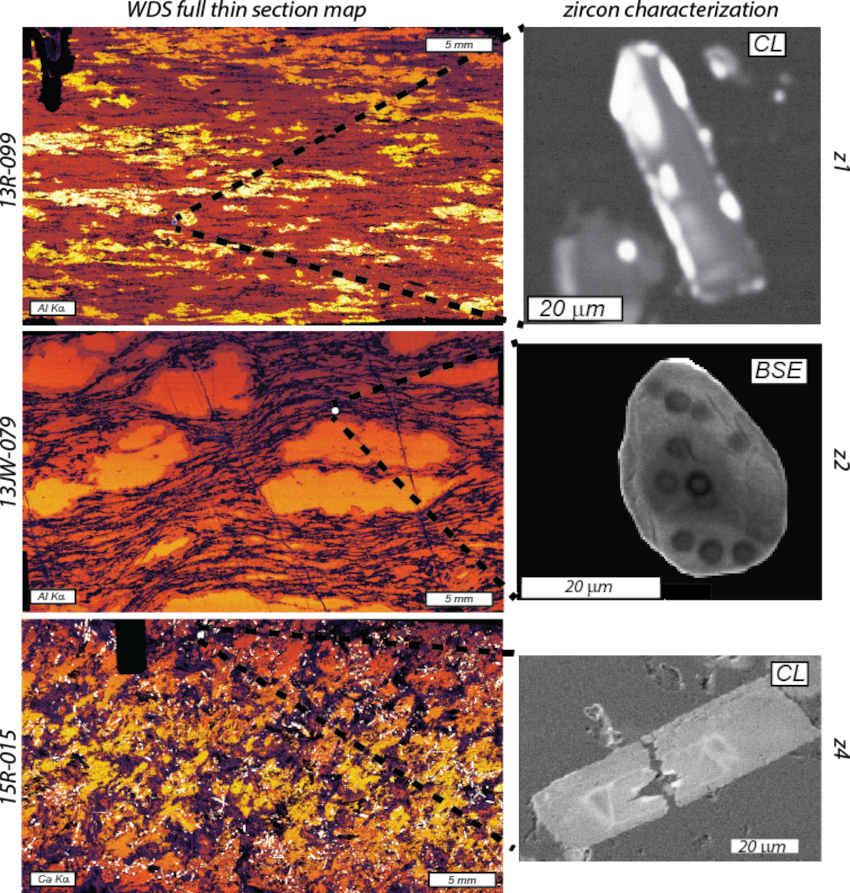
Figure 6: Method for finding zircon in full thin sections via WDS mapping.
Discussion
A ca. 2.1 Ga U-Pb zircon age for the Chipman and Kazan dikes falsifies correlation with the younger, large mafic complex along the northern STZ (i.e., Daly Bay and Kramintuar). However, this age does align well with recent data from the Clearwater anorthosite (Card et al., 2021), and by extension, the Virgin River dike swarm south of the Athabasca Basin. Although the new ca. 2.1 Ga ages for the Chipman and Kazan swarms are limited to two samples for each swarm, these ages are bolstered by the additional U-Pb zircon geochronology that exists for mafic complexes along the central STZ. We interpret the Virgin River dikes, Clearwater anorthosite, Chipman dike swarm, and Kazan dike swarm formed at ca. 2.11 Ga for distances exceeding 800 km along the STZ, and comprise the STZ LIP phase I. Although not along the STZ, a suite of regionally extensive sills within the Hearne subprovince, the Griffin gabbro sills (Fig. 1; Aspler et al., 2002) are intruded into Paleoproterozoic sedimentary rocks of Hurwitz Basin. The Griffin gabbros were emplaced at 2.1 Ga and are asthenospherically derived, while Nd isotopic ratios suggest limited contamination by local crust. The gabbros are interpreted to record extensional magmatism during the breakup of an Archean supercontinent. The Griffin gabbro sills are remarkably similar to both Chipman and Kazan dike swarms, occur within 100 km of Angikuni Lake, and likely also represent STZ LIP phase I magmatism.
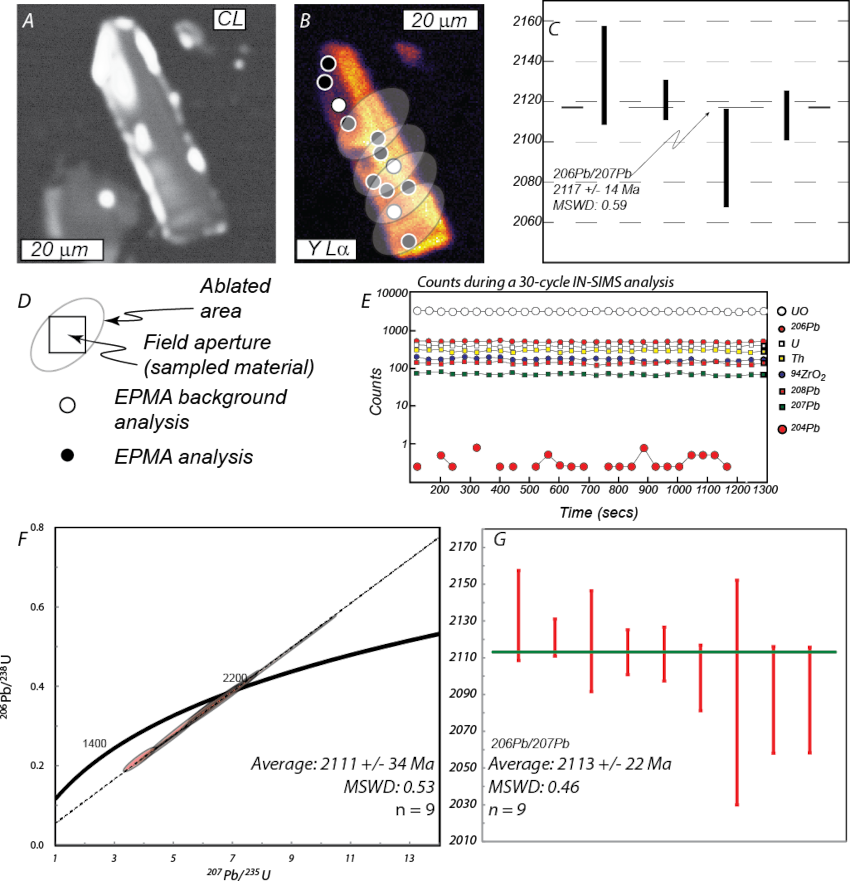
Figure 7: Geochronology results from Chipman and Kazan dike swarms. A-B) CL and WDS Y Lα map of a single zircon grain from the Chipman dike swarm; C) All geochronology results from grain shown in Figure 7 A-B; D) schematic showing method for limiting area analyzed for isotopic analysis on Cameca IMS 1270; E) example of a 30-cycle isotopic analysis showing minimal 204Pb counts. F-G) All data from Chipman and Kazan dike swarms suggesting a ca. 2.11 Ga crystallization age.
The origin of the STZ has been vigorously debated for decades. Debate centers on whether an ocean basin existed between Rae and Hearne subprovinces before ca. 1.92 Ga (Regan et al., 2017a). Because there is no evidence aside from widespread deformation and metamorphism compatible with the consumption of an oceanic plate beneath the Rae subprovince between 2.0 and 1.9 Ga, Regan et al. (2014) interpreted the kinematic evolution of the STZ to have resulted from the tectonic evolution of the Trans-Hudson and Taltson-Thelon orogens. The existence of ca. 2.1 Ga extensional-type LIP magmatism along the Rae-Hearne subprovince boundary would be consistent with rifting along eastern Rae subprovince, but the lack of arc magmatism on either side of the STZ paired with a lack of foredeep sedimentation and high-P assemblages makes invoking subduction problematic. Also, the existence of Archean subduction-altered lithospheric mantle across the STZ prior to voluminous Christopher Island Formation volcanism at 1.83 Ga (Cousens et al., 2001) makes full-scale rifting difficult to justify as it would have reworked much of this older mantle. Therefore, we interpret the STZ LIP phase I to represent failed rifting between Rae and Hearne subprovinces at 2.1 Ga, compatible with the proximity to Griffin gabbro sills, the lack of classic subduction signatures associated with the STZ, and the deposition of Paleoproterozoic sediments in local basins along the STZ (Martel et al., 2008). Transpressional deformation along the STZ from ca. 1.93-1.82 Ga is interpreted to have resulted in basin inversion and crustal thickening along the inherited structural weakness. Therefore, we interpret the STZ to represent an abandoned ca. 2.1 Ga rift that was then reactivated during the assembly of the Nuna supercontinent, and more specifically, the collision of cratonic blocks with the western Churchill Province (Fig. 8).
*Our new data support a mafic dike event at 2.1 Ga correlative with other occurrences, but there is evidence for additional mafic magmatism at 1.9 Ga especially within the eastern parts of the Chipman swarm. Additional work will be required to distinguish the relative amounts of the two events.*
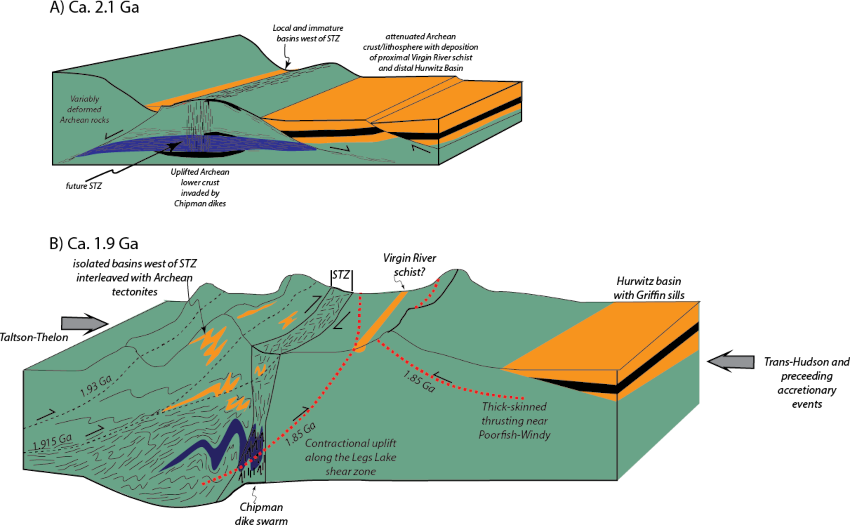
Figure 8: Paleoproterozoic evolution of the STZ.
References:
Aspler, L.B., Cousens, B.L., and Chiarenzelli, J.R., 2002a, Long-distance intracratonic transport of mafic magmas during opening of the Manikewan ocean (Trans-Hudson orogen): Griffin gabbro sills (2.11 Ga), Hurwitz Basin, Nunavut, Canada: Precambrian Research, v. 117, p. 269-294.
Aspler, L.B., Chiarenzelli, J.R., Cousens, B.L., Valentino, D., 1999, Precambrian Geology, Northern Angikuni Lake, and a transect across the Snowbird Tectonic Zone, western Angikuni Lake, Northwest Territories (Nunavut): Current Research – 199c, Geological Survey of Canada, p. 107-118.
Berman, R.G., Davis, W.J., and Pehrsson, S., 2007, Collisional Snowbird tectonic zone resurrected: Growth of Laurentia during the 1.9 Ga accretionary phase of the Hudsonian orogeny: Geology, v. 35, n. 10, p. 911-914, doi:10.1130/G23771A.1.
Card, C.D., Bethune, K.M., Davis, W.J., Rayner, N., and Ashton, K.E., 2014, The case for a distinct Taltson orogeny: Evidence form Northwest Saskatchewan, Canada: Precambrian Research, v. 255, p. 245 – 265.
Card, C.D., Bethune, K.M., Rayner, N., Ashton, K.E., 2021, Tectonic significance of the Virgin River shear zone of the Canadian Shield and implications for the origin of the Snowbird tectonic zone of Laurentia: Precambrian Research, v. 361.
Chamberlain, K.R., Schmitt, A.K., Swapp, S.M., Harrison, M., Swoboda-Colberg, N., Bleeker, W., Peterson, T.D., Jefferson, C.W., and Khuduley, A.K., 2010, In situ U-Pb SIMS (IN-SIMS) micro-baddeleyite dating of mafic rocks: Method with examples: Precambrian Research, v. 183, p. 379-387.
Cousens, B.L., Aspler, L.B., Chiarenzelli, J.R., Donaldson, J.A., Sandeman, H., Peterson, R.D., LeCheminant, A.N., 2001, Enriched Archean lithospheric mantle beneath western Churchill Province tapped during Paleoproterozoic orogenesis: Geology, v. 29, n. 9, p. 827-830.
Eade, K.E., 1986, Precambrian geology of the Tulemalu Lake-Yathkyed Lake area, District of Keewating, Geological Survey of Canada, Paper 84-11, 31 p.
Flowers, R., Bowring, S.A., Mahan, K.H., and Williams, M.L., 2006, Timescales and significance of high pressure, high-temperature metamorphism and mafic dike anatexis, Snowbird tectonic zone, Canada: Contribution to Mineralogy and Petrology, v. 151, n. 5, p. 558-581, doi:10.1007/s00410-006-0066-7.
Hanmer, S. and Williams, M.L., 2001, Targeted fieldwork in the Daly Bay complex, Hudson Bay, Nunavut: Geological Survey of Canada Current Research 2001-C15, p. 1-26.
Hoffman, P.F., 1988, United Plates of America, the birth of a craton: Early Proterozoic assembly and growth of Laurentia: Annual Review of Earth and Planetary Sciences, v. 16, p. 543-603, doi:10.1146/annurev.ca.16.050188.002551.
Mahan, K.H., and Williams, M.L., 2005, Reconstruction of a large deep-crustal terrane: Implication for the Snowbird tectonic zone and early growth of Laurentia: Geology, v. 33, n. 5, p. 385-388, doi:10.1130/G21273.1.
Martel, E., van Breemen, O., Berman, R.G., and Pehrsson, S., 2008, Geochronology and tectonometamorphic history of the Snowbird Lake area, Northwest Territories, Canada: New insights into the architecture and significance of the Snowbird tectonic zone: Precambrian Research, v. 161, n. 3-4, p. 201-230, doi:10.1016/j.precamres.2007.07.007.
Pearce, J.A., Ernst, R.E., Peate, D.W., and Rogers, C., 2021, LIP Printing: Use of immobile element proxies to characterize Large Igneous Provinces in the geologic record: Lithos, v. 392-393, 28 p.
Regan, S.P., Williams, M.L., Chiarenzelli, J.R., Grohn, L., Mahan, K.H., and Gallagher, M., 2017b, Isotopic evidence for Neoarchean continuity across the Snowbird Tectonic Zone, western Churchill Province: Precambrian Research, v. 300, p. 201-222.
Regan, S.P., Williams, M.L., Leslie, S., Mahan, K.H., Jercinovic, M.J., and Holland, M.E., 2014, The Cora Lake shear zone, Athabasca granulite terrane, an intraplate response to far-field orogenic processes during the amalgamation of Laurentia: Canadian Journal of Earth Sciences, v. 51, p. 877-901.
Sanborn-Barrie, M., Carr, S.D., and Theriault, R., 2001, Geochronological constraints on metamorphism, magmatism, and exhumation of deep-crustal rocks of the Kramanitaur Complex with implications for the Paleoproterozoic evolution of the Archean western Churchill Province, Canada: Contributions to Mineralogy and Petrology, v. 141, p. 592-612.
Sun, S-s., McDonough, W.F., 1989, Chmeical and isotopic systematics of oceanic basalts: implications for mantle compositions and process: In: Saunder, A.D., Norry, M.J. (Eds), Magmatism in Ocean Basins, v. 42, The Geological Society of London Special Publication, p. 313-345.
Williams, M.L., Hanmer, S., Kopf, C., and Darrach, M., 1995, Syntectonic generation and segregation of tonalitic melts from amphibolite dikes in the lower crust, Striding-Athabasca mylonite zone, northern Saskatchewan: Journal of Geophysical Research, V. 100, n. B8, p. 15,717-15,734, doi:10.1029/95JB00760.
Williams, M.L., and Flowers, R.M., 2008, The Chipman dyke swarm, Saskatchewan, Canada: Component of the 1.9 Ga Snowbird large igneous province in the western Canadian Shield: LIP of the Month, January, 2008: http://www.largeigneousprovinces.org/08jan
